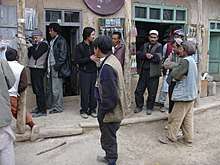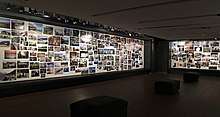Jayce Salloum
Jayce Salloum (born 1958) is a Canadian multidisciplinary artist.
Jayce Salloum | |
|---|---|
 Salloum, second from left, holding video camera, working in Panjaw, Bamiyan, Afghanistan (2008). | |
| Born | 1958 |
| Nationality | Canadian |
| Education | University of California, San Diego (MFA, 1988), Whitney Museum of American Art, Independent Study Program, (1988), San Francisco Art Institute (BFA, 1980), Banff Centre for Arts and Creativity (1978-1979), Banff School of Fine Arts (1975) |
| Known for | photography, film and video, installation art, curating |
| Awards | Governor General's Award in Visual and Media Arts (2014) |
Early life
A grandson of Syrian immigrants from what is now Lebanon's Beqaa Valley, he was born and raised in Kelowna and since 1997 has been based in Vancouver.[1] He earned a BFA degree from the San Francisco Art Institute in 1980, followed by an Master of Fine Arts degree from the University of California, San Diego in 1988.[2][3] Salloum has lived and worked in Beirut, New York, San Francisco, Toronto and elsewhere.
Career
A multidisciplinary artist, since 1978 Salloum has produced work in installation, photography, video, performance and text, as well as curating and coordinating a vast array of cultural projects.[4][5][3][6]
His work is included in the permanent collections of the Asia Art Archive,[7] the Centre Pompidou, Paris[8] and the National Gallery of Canada.[9]
In 2001, Salloum was invited to exhibit at the Canadian Museum of Civilization.[10] The exhibition was set to open in October of that year but was cancelled in the aftermath of 9/11. Central to the museum's decision to cancel the exhibition was Salloum's video installation, untitled part 1: everything and nothing, in which Salloum interviews Soha Bechara who was detained for nearly ten years at Khiam prison in Southern Lebanon, which was at the time occupied by Israel.[11] In the video, Bechara expresses the need to resist the Israeli occupation, which was seen as controversial by the directors of the Canadian Museum of Civilization. The bigoted gesture to cancel the exhibition and censor the voices of Arab-Canadian artists was widely condemned by the public.[12][13] After a discussion ensued in the House of Commons, in which Prime Minister Jean Chrétien voiced his support for the exhibition, the show opened on schedule.[14]
In 2014, he won the Governor General's Awards in Visual and Media Arts.[15] In 2016 he was a nominee for the Scotiabank Photography Award.[16]
A Living Archive

From 1982 onward, Salloum accumulated vast amounts of research materials for what would become the installation Kan Ya Ma Kan/There was and there was not (1995).[17] For Salloum, this material constituted a living archive that "called into question notions of history and research methodology, their role in the effacement of histories, and the mediated process inherent in the representation and (mis)understanding of another culture…"[17] This notion of a living archive recurs throughout Salloum's body of work and can be seen in both his installation work as well as his curatorial engagements.[18] Archival interventions are a mode of artistic production in Salloum's native Lebanon that became common place after the 1975-1990 Lebanese Civil War, and much of the work of Salloum's colleagues—in particular, Walid Raad, Akram Zaatari, Joana Hadjithomas and Khalil Joreige, and Lamia Joreige—is in some manner oriented towards the archive.[19] The archives employed in Salloum's untitled series, for example, are not static but are instead dynamic.[17]
Much of the ongoing untitled series centres around questions of resistance and representation.[20] The traces that one leaves behind in place—the traces of the self that form what Salloum refers to as the histories of the self—are videotaped by Salloum in an effort to bring the personal space into "the context of the intrinsic social and political site."[17]
In 1992, two years after the end of the Lebanese Civil War, Jayce Salloum visited Lebanon with his then assistant, artist Walid Raad.[21] Over the year, Salloum recorded over 200 hours of videotape, as well as several thousand photographs. He also accrued a half ton of documents and found film. This archive would form the basis of two films, This is Not Beirut (1994) and Up to the South (Talaeen a Junuub) (1993), as well as the series of photos titled (sites+) demarcations (1992-94).[21] By drawing upon large volumes of media, from photography to video, Salloum's installations try to capture the significant number of images that attempt to capture (and represent) the MENA region. The 1995 installation Kan ya ma Kan (كان يا ما كان) (There was and there was not) was a culmination of a process of accumulation from 1982 onward, and included some of the 1992 material, and explored the production of middle east history and knowledge and the role of the artist in producing such a history.[21] Museum viewers were encouraged to physically interact with the material. They could touch and reorganize what was presented in front of them, becoming a part of the exhibition and reconstruction of a history.[21]
.jpg)
Works
- 1985–1987 The Ascent of Man - Parts I, II & III video[22][23][24]
- 1988 Once you’ve shot the gun you can't stop the bullet[25]
- 1990: Introduction to the End of an Argument (with Elia Suleiman)[15]
- 1999–ongoing: Everything and nothing and other works from the ongoing videotape, titled, 1999–ongoing (with Souha Bechara)[15]
References
- "Civilization.ca - the Lands within Me - Artists' biographies".
- "Reclamation Artist".
- "Jayce Salloum | Video Data Bank".
- "Videos by Jayce Salloum".
- "Jayce Salloum – Location/Dis-location(s): Beyond the pale". McCord Museum.
- Hoolboom, Mike (2004-04-14). Practical Dreamers: Conversations with Movie Artists. ISBN 9781552452004.
- "Jayce Salloum: History of the Present".
- "Musée national d'art moderne – Centre Pompidou". 2020-02-25.
- "Jayce Salloum".
- Campbell, Deborah. "Reclamation Artist". Canadian Art. Retrieved 2020-06-05.
- Fraser, Graham (October 19, 2001). "Controversial Exhibit Draws Fire". Toronto Star.
- Campbell, Deborah. "Reclamation Artist". Canadian Art. Retrieved 2020-06-05.
- "Downtown Eastside artist Jayce Salloum wins Governor General's Award in Visual and Media Arts". The Georgia Straight. 2014-03-04. Retrieved 2020-06-05.
- Campbell, Deborah. "Reclamation Artist". Canadian Art. Retrieved 2020-06-05.
- Downtown Eastside artist Jayce Salloum wins Governor General's Award in Visual and Media Arts, by Charlie Smith, March 4th, 2014
- "Meet the 2016 Scotiabank Photography Award nominees | CBC Arts".
- Salloum, Jayce (2006). "Sans titre/Untitled: The Video Installation as an Active Archive". In Merewether, Charles (ed.). The Archive. London and Cambridge, MA: Whitechapel Gallery and The MIT Press. pp. 185-186. ISBN 978-0-85488-148-2.
- Salloum, Jayce (2007). "sans titre/untitled: the video installation as an active archive". In Grossman, Alan; O'Brien, Áine (eds.). Projecting Migration: Transcultural Documentary Practice. Wallflower Press. ISBN 9781905674046.
- Elias, Chad (2018). Posthumous Images: Contemporary Art and Memory Politics in Post–Civil War Lebanon. Durham, NC, and London: Duke University Press. pp. 2–4. ISBN 978-0-8223-4766-8.
- "Jayce Salloum". Vimeo. Retrieved 2020-05-09.
- Salloum, Jayce (2007). "sans titre /untitled: the video installation as an active archive". Projecting Migration: Transcultural Documentary Practice. London: Wallflower Press.
- "The Ascent of Man - Parts I, II & III | WWW.li-ma.nl".
- "Vanguard". 1988.
- "The Independent". 1987.
- "Once You've Shot the Gun You Can't Stop the Bullet | www.li-ma.nl". www.li-ma.nl. Retrieved 2020-06-01.